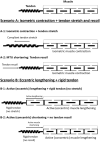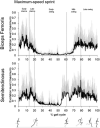A Conceptual Exploration of Hamstring Muscle-Tendon Functioning during the Late-Swing Phase of Sprinting: The Importance of Evidence-Based Hamstring Training Frameworks
- PMID: 37668895
- PMCID: PMC10687166
- DOI: 10.1007/s40279-023-01904-2
A Conceptual Exploration of Hamstring Muscle-Tendon Functioning during the Late-Swing Phase of Sprinting: The Importance of Evidence-Based Hamstring Training Frameworks
Abstract
An eccentrically lengthening, energy-absorbing, brake-driven model of hamstring function during the late-swing phase of sprinting has been widely touted within the existing literature. In contrast, an isometrically contracting, spring-driven model of hamstring function has recently been proposed. This theory has gained substantial traction within the applied sporting world, influencing understandings of hamstring function while sprinting, as well as the development and adoption of certain types of hamstring-specific exercises. Across the animal kingdom, both spring- and motor-driven muscle-tendon unit (MTU) functioning are frequently observed, with both models of locomotive functioning commonly utilising some degree of active muscle lengthening to draw upon force enhancement mechanisms. However, a method to accurately assess hamstring muscle-tendon functioning when sprinting does not exist. Accordingly, the aims of this review article are three-fold: (1) to comprehensively explore current terminology, theories and models surrounding muscle-tendon functioning during locomotion, (2) to relate these models to potential hamstring function when sprinting by examining a variety of hamstring-specific research and (3) to highlight the importance of developing and utilising evidence-based frameworks to guide hamstring training in athletes required to sprint. Due to the intensity of movement, large musculotendinous stretches and high mechanical loads experienced in the hamstrings when sprinting, it is anticipated that the hamstring MTUs adopt a model of functioning that has some reliance upon active muscle lengthening and muscle actuators during this particular task. However, each individual hamstring MTU is expected to adopt various combinations of spring-, brake- and motor-driven functioning when sprinting, in accordance with their architectural arrangement and activation patterns. Muscle function is intricate and dependent upon complex interactions between musculoskeletal kinematics and kinetics, muscle activation patterns and the neuromechanical regulation of tensions and stiffness, and loads applied by the environment, among other important variables. Accordingly, hamstring function when sprinting is anticipated to be unique to this particular activity. It is therefore proposed that the adoption of hamstring-specific exercises should not be founded on unvalidated claims of replicating hamstring function when sprinting, as has been suggested in the literature. Adaptive benefits may potentially be derived from a range of hamstring-specific exercises that vary in the stimuli they provide. Therefore, a more rigorous approach is to select hamstring-specific exercises based on thoroughly constructed evidence-based frameworks surrounding the specific stimulus provided by the exercise, the accompanying adaptations elicited by the exercise, and the effects of these adaptations on hamstring functioning and injury risk mitigation when sprinting.
© 2023. The Author(s).
Conflict of interest statement
The authors declare they have no conflicts of interest with the content of this review.
Figures







Similar articles
-
Home treatment for mental health problems: a systematic review.Health Technol Assess. 2001;5(15):1-139. doi: 10.3310/hta5150. Health Technol Assess. 2001. PMID: 11532236
-
Physical exercise training interventions for children and young adults during and after treatment for childhood cancer.Cochrane Database Syst Rev. 2016 Mar 31;3(3):CD008796. doi: 10.1002/14651858.CD008796.pub3. Cochrane Database Syst Rev. 2016. PMID: 27030386 Free PMC article.
-
Cost-effectiveness of using prognostic information to select women with breast cancer for adjuvant systemic therapy.Health Technol Assess. 2006 Sep;10(34):iii-iv, ix-xi, 1-204. doi: 10.3310/hta10340. Health Technol Assess. 2006. PMID: 16959170
-
Intermuscular differences in force generation ability among biarticular hamstring muscles during the late swing phase in maximal speed sprinting.Sports Biomech. 2025 May;24(5):1309-1326. doi: 10.1080/14763141.2023.2236076. Epub 2023 Jul 21. Sports Biomech. 2025. PMID: 37477227
-
The use of Open Dialogue in Trauma Informed Care services for mental health consumers and their family networks: A scoping review.J Psychiatr Ment Health Nurs. 2024 Aug;31(4):681-698. doi: 10.1111/jpm.13023. Epub 2024 Jan 17. J Psychiatr Ment Health Nurs. 2024. PMID: 38230967
Cited by
-
The impact of exercise therapy on rehabilitation outcomes after anterior cruciate ligament reconstruction: a network meta-analysis.BMC Musculoskelet Disord. 2025 Jul 4;26(1):632. doi: 10.1186/s12891-025-08876-6. BMC Musculoskelet Disord. 2025. PMID: 40615833 Free PMC article.
-
Technical Sprinting in the Early Phase of Hamstring Injury Rehabilitation to Accelerate Return to Full Participation in Track and Field Athletes: A Comparative Study of Two Rehabilitation Strategies.Cureus. 2024 Apr 14;16(4):e58268. doi: 10.7759/cureus.58268. eCollection 2024 Apr. Cureus. 2024. PMID: 38752061 Free PMC article.
-
Football (soccer) match-derived hamstring muscles residual fatigue can be monitored using early rate of torque development.Eur J Appl Physiol. 2025 May;125(5):1449-1461. doi: 10.1007/s00421-024-05694-x. Epub 2024 Dec 27. Eur J Appl Physiol. 2025. PMID: 39725689
-
Impact of Hamstring Graft on Hamstring Peak Torque and Maximum Effective Angle After Anterior Cruciate Ligament Reconstruction: An Exploratory and Preliminary Study.Bioengineering (Basel). 2025 Apr 28;12(5):465. doi: 10.3390/bioengineering12050465. Bioengineering (Basel). 2025. PMID: 40428084 Free PMC article.
-
An overview and prediction of 100 mm performance over 40 years during the Athletics World Championships.Biol Sport. 2025 Apr 1;42(3):313-325. doi: 10.5114/biolsport.2025.146783. eCollection 2025 Jul. Biol Sport. 2025. PMID: 40656985 Free PMC article.
References
-
- Ekstrand J, Bengtsson H, Walden M, Davison M, Khan KM, Hagglund M. Hamstring injury rates have increased during recent seasons and now constitute 24% of all injuries in men's professional football: the UEFA Elite Club Injury Study from 2001/02 to 2021/22. Br J Sports Med. 2022;57(5):292–298. doi: 10.1136/bjsports-2021-105407. - DOI - PMC - PubMed
Publication types
MeSH terms
LinkOut - more resources
Full Text Sources

